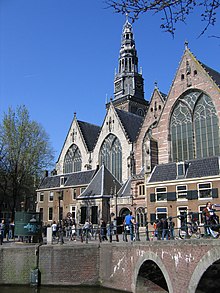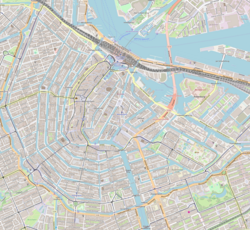Oude Kerk, Amsterdam

Oude Kerk, viewed from across the Oudezijds Voorburgwal
|
|
| Established | ca. 1213 |
|---|---|
| Location |
Oudekerksplein 23 Amsterdam, Netherlands |
| Coordinates | 52°22′28″N 4°53′53″E / 52.3744°N 4.8980°ECoordinates: 52°22′28″N 4°53′53″E / 52.3744°N 4.8980°E |
| Type | church |
| Director | Jacqueline Grandjean |
| Website | http://www.oudekerk.nl/en/ |
The 800-year-old Oude Kerk ("old church") is Amsterdam’s oldest building and oldest parish church, founded ca. 1213 and consecrated in 1306 by the bishop of Utrecht with Saint Nicolas as its patron saint. After the Reformation in 1578 it became a Calvinist church, which it remains today. It stands in De Wallen, now Amsterdam's main red-light district. The square surrounding the church is the Oudekerksplein.
By around 1213, a wooden chapel had been erected at the location of today's Oude Kerk. Over time, this structure was replaced by a stone church that was consecrated in 1306.
The church has seen a number of renovations performed by 15 generations of Amsterdam citizens. The church stood for only a half-century before the first alterations were made; the aisles were lengthened and wrapped around the choir in a half circle to support the structure. Not long after the turn of the 15th century, north and south transepts were added to the church creating a cross formation. Work on these renovations was completed in 1460, though it is likely that progress was largely interrupted by the great fires that besieged the city in 1421 and 1452.
Before the Alteratie, or Reformation in Amsterdam of 1578, the Oude Kerk was Roman Catholic. Following William the Silent’s defeat of the Spanish in the Dutch Revolt, the church was taken over by the Calvinist Dutch Reformed Church. Throughout the 16th-century battles, the church was looted and defaced on numerous occasions, first in the Beeldenstorm of 1566, when a mob destroyed most of the church art and fittings, including an altarpiece with a central panel by Jan van Scorel and side panels painted on both sides by Maarten van Heemskerck. Only the paintings on the ceiling, which were unreachable, were spared.
...
Wikipedia

